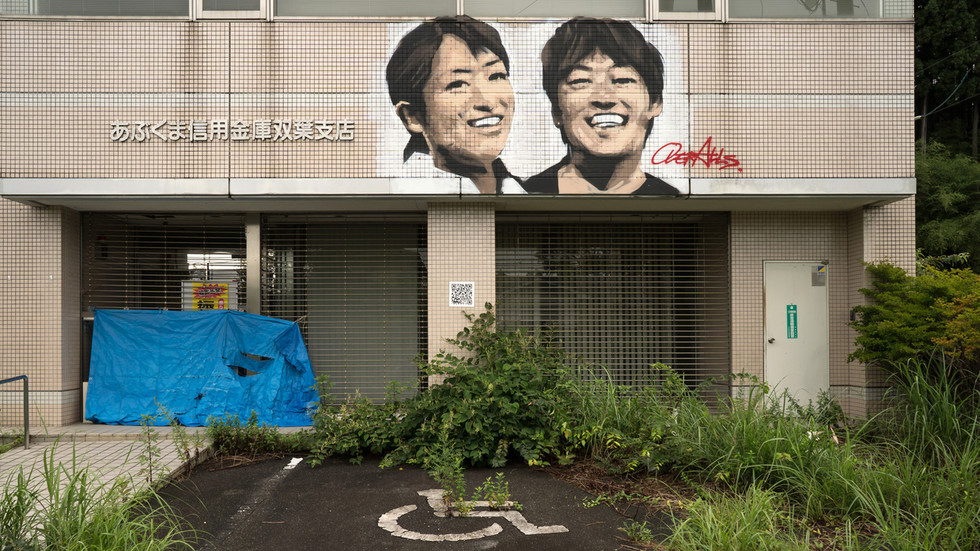
Washington wants Beijing to repeat the fate of Tokyo, whose economic stagnation was triggered by a pact with America
By Timur Fomenko, a political analyst

FILE PHOTO: An artwork titled “HUMAN POWER !!!” on a wall of a shuttered bank branch building in Futaba, Fukushima, Japan. © Tomohiro Ohsumi/Getty Images
With China’s ongoing economic slowdown, one of the predictions for its fate voiced recently is that it could suffer from “Japanification.”
The term refers to the recent history of Japan, which has experienced relative economic stagnation since the 1990s, with its current GDP continuing to be below what it was in 1995. This episode is often referred to as Japan’s ‘lost decade’. Although the country recovered in the first decade of the 2000s, its economy slumped again amid the chaos of the Fukushima nuclear disaster and has never truly recovered since. The reasons identified for this poor performance include high levels of public debt, an asset price bubble, and low inflation.
It is inevitable that given China’s current difficulties, its situation is now being compared to Japan’s. But there is more to it than that, because the beginning of Japan’s decline was not just a product of poor economic policies but also of geopolitics. Similar to how the US now sees China, Tokyo was once viewed as a competitor to be crushed before it could overtake the US in economic size, and with the 1985 Plaza Accord – designed to artificially weaken the US dollar against other currencies, including the yen, to reduce the US trade deficit – America did just that. Japan has since gone from being an ‘economy of the future’ to one of stagnation, and now the US hopes to curtail China’s rise in a similar, albeit more adversarial way.

First and foremost, be it friend or foe, the US absolutely resents any country being bigger than itself, seeing any upstart as a potential threat to American dominance over the world’s most strategic high-end goods and technologies. In the 1980s, Japan was undergoing an economic boom much like the one seen in China in recent years. It was the world’s second-largest economy and was poised to overtake the US. In the year 1995, Japan’s GDP peaked at $5.4 trillion, compared to America’s $7.6 trillion.
In the preceding decade, the US had taken tremendous fault with Japan’s rise and began to scaremonger about Tokyo, predicting an “economic Pearl Harbor” and, surprisingly enough, repeating many of the same attacks it is making against China today. The accusations levelled at Japan included the familiar-sounding “unfair trade practices” and “theft of intellectual property.” The result was that the US began to take measures against Japanese companies and wield protectionist policies to push its products out of the American market, while at the same time demanding more access to the Japanese one.
Then, in the year 1985, Tokyo, as well as a number of other countries, capitulated to US demands and the Plaza Accord was sealed, forcibly devaluing the US dollar against the Japanese yen, and therefore undercutting Japan’s competitiveness. Over the coming decade, this had a cumulative effect, as Japanese goods became more expensive and importers shied away from them. The country’s central bank tried to keep the yen’s value down, which led to a stock price bubble, which then burst, plunging the country into recession and starting the ’lost decade’.

The US effectively crushed the rise of Japan, but only by getting it to agree to economic humiliation. Washington wants to achieve a similar “economic subjugation” of Beijing today, but with an added military dynamic. It wants to carve up China’s market for its own firms while systematically, both at home and abroad, undermining the success of Chinese companies. It also hopes that, in turn, China will react in ways that will stifle its own economic growth and kick off its own ‘lost decade’ where it will no longer be able to compete with the US.
The key point is that the US does not wish to see competing economies thrive. The post-war Japanese state has been successful, but it has never been allowed to grow to the point where it could shake off US control over it. Similarly, the US has taken measures to cripple the autonomy and prosperity of Germany, especially through exploiting the Ukraine conflict. China of course, is seen as both a competitor and an adversary, and as such there is no goodwill for China’s rise. A Japanified China is one which will benefit the interests of the US, one that has less competitive products, and is therefore forced to accommodate more American ones.
The statements, views and opinions expressed in this column are solely those of the author and do not necessarily represent those of RT.




